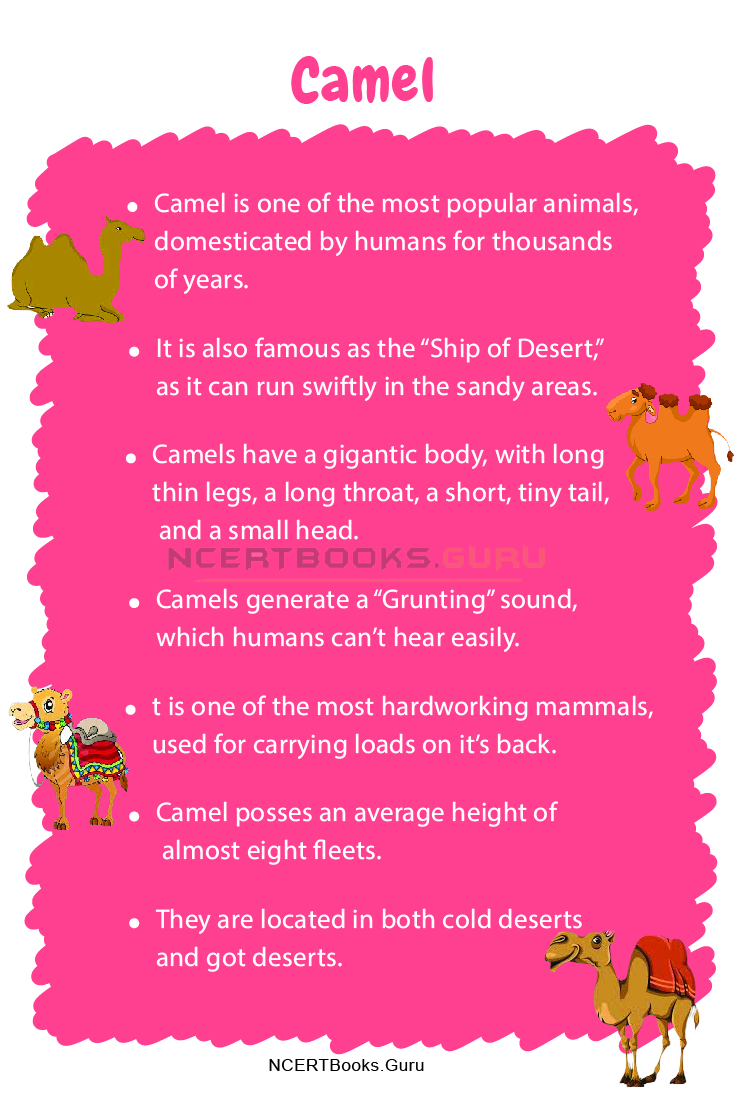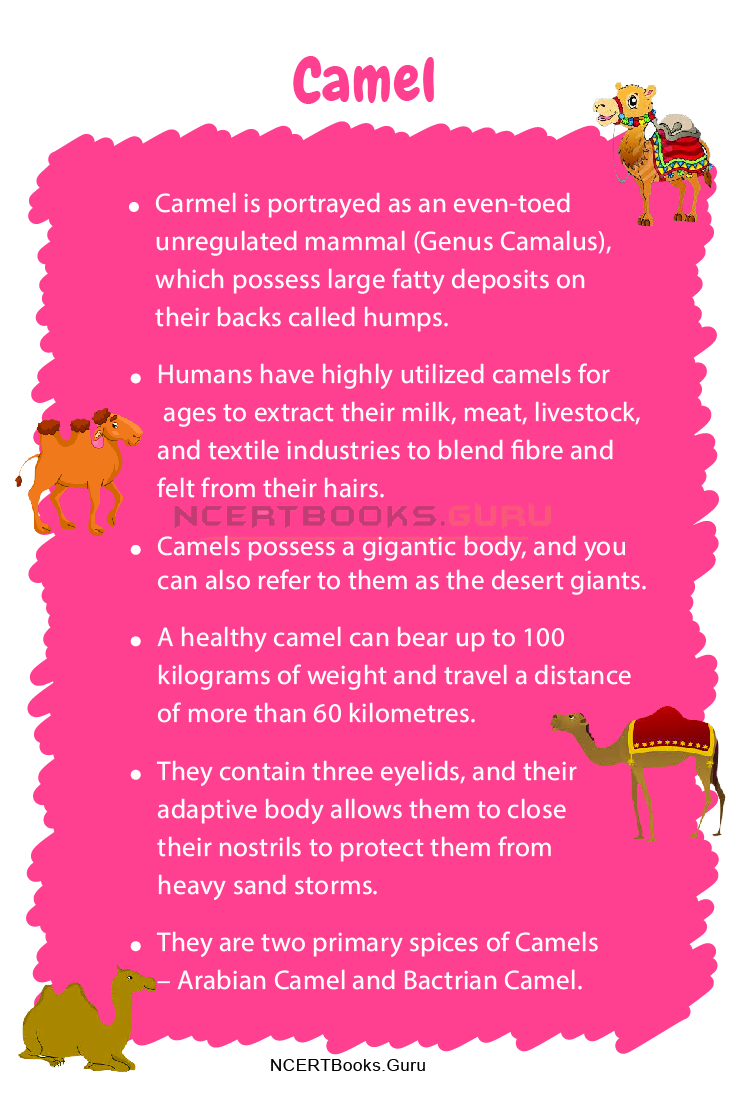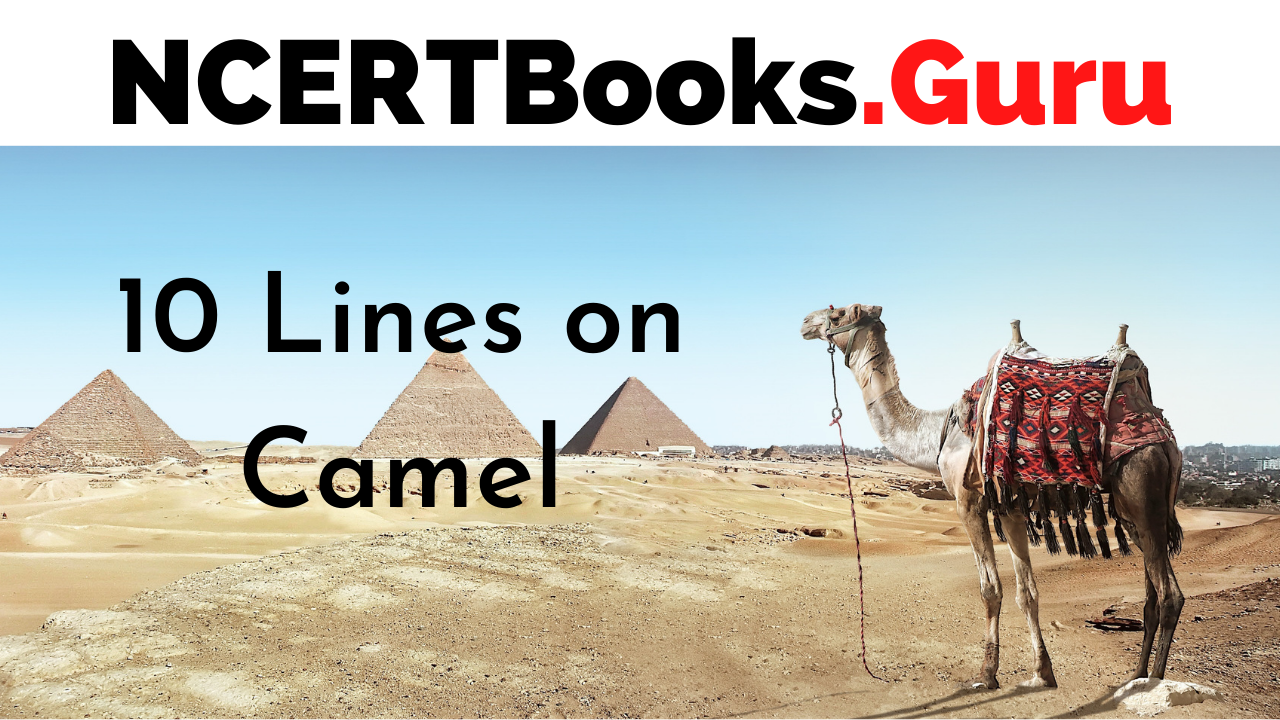10 Lines on Camel: Camels have been beneficial for humankind for decades. Whether it is the ancient age of modern times, camels have provided the best service to humans. In ancient times, Camels were one of the primary modes of transportation. Camels have encrypted their names in the chapters of history as a royal animal.
When we hear the term “Ship of desert,” the first thing that strikes our mind is the powerful and steady mammal Camel. Camel is one of the most useful domestic creatures, domesticated by humans for more than thousands of years. It is mainly an inhabitant of deserts of Middle East Areas, Africa, Western India, and many more sandy areas around the globe. It lives in a place with lacks the existence of water and vegetation, surrounded by sand.
Humans utilize camels in various industries. Their massive appearance and their strength define them to cover large distances. They are a powerhouse of strength and endurance and can be used for long journeys. Camels are used for their milk, skin, meat, and many other purposes.
In this article, we will discuss various traits of the Camel. And we will be portraying ten lines for all age groups ranging from kids to teenagers to educate them about Camel, one of the most important domestic animals. Here we will explore different utilities of Camel in our world.
Enhance your vocabulary and writing skills with 10 Lines Essays available. Spark up the creativity in you and access various Topics on 10 Lines all in one place.
Set 1 – 10 Lines on Camel for kids
This set is specially designed for students from classes 1, 2, 3, 4, and 5.
- Camel is one of the most popular animals, domesticated by humans for thousands of years.
- It is also famous as the “Ship of Desert,” as it can run swiftly in the sandy areas.
- Camels have a gigantic body, with long thin legs, a long throat, a short, tiny tail, and a small head.
- Camels generate a “Grunting” sound, which humans can’t hear easily.
- It is one of the most hardworking mammals, used for carrying loads on its back.
- Camel possesses an average height of almost eight fleets.
- They are located in both cold deserts and got deserts.
- Camels possess a high endurance level and can live without a single drop of water for several days.
- Male camels are termed bull camels, and Female Camels are known as cow camels.
- The average age of a camel’s survival is 40 years to 50 years.

Set 2 – 10 Lines on Camel for School Children
This set is beneficial for students from 6, 7, and 8.
- The Caramels are tamed and used by the human population for more than a thousand years.
- Camels are extensively used in commercial fields to manufacturing different items like soap, skin creams, chocolates, feta, and much more.
- People in Middle Eastern parts of the world and Africa consume the camels’ meat, while camel milk is famous worldwide.
- Camel comes from the category of herbivores mammals. Therefore they eat plants, veggies, or fruits.
- There are more than 30 million Camels around the globe. And an African Country, Somalia, contains the largest number of Carmel.
- A group of horses moving towards is quoted as “Caravan.”
- Their humps are a storehouse of food and water, which helps them survive without long durations.
- Camels are the ideal transportation method in desert areas as they possess high speed and swiftness in sandy areas.
- Humans utilize camels to extract milk, meat, fur, and skin from them.
- A camel’s body is designed efficiently with long legs and a steady body to base the desert’s high temperatures, and it contains three eyelids to protect them from heavy sandy storms.
Set 3 – 10 Lines on Camel for Higher Class Students
This set is specifically designed for students from classes 9, 10, 11, and 12. Students preparing for competitive examinations can also follow this set.
- Carmel is portrayed as an even-toed unregulated mammal (Genus Camalus), which possess large fatty deposits on their backs called humps.
- Humans have highly utilized camels for ages to extract their milk, meat, livestock, and textile industries to blend fibre and felt from their hairs.
- Camels possess a gigantic body, and you can also refer to them as the desert giants. A wholly grown adult camel is generally measured 1.85 m (6 ft 1 in) at the shoulder and is measured 2.15 m (7 ft 1 in) at the hump.
- The Humps of the camels do not store the water directly; the water is stored in the fatty layers, which are metabolized to release grams of water as per the Camel’s requirements.
- A healthy camel can bear up to 100 kilograms of weight and travel a distance of more than 60 kilometres.
- They contain three eyelids, and their adaptive body allows them to close their nostrils to protect them from heavy sand storms.
- Camels primarily belong to the Camelidae family, discovered in America about 40 million years ago. Llama, vicuña, guanaco are some of the prominent camelids of South America.
- They are two primary spices of Camels – Arabian Camel and Bactrian Camel.
- Camel possesses a highly adaptive body that prevents protein deficiency and helps them survive consuming thorns, saltbush, and dry leaves. And when the Camel gets a lot of food, they overeat to store it in the form of fatty acids.
- They are the beauty of the deserts with a calm and composed nature, which allows them to transport heavy weights over long distances. In the desert areas, they are the perfect companion of people and receive love and affection for their services.

Frequently Asked Questions on Camel
Question 1.
How have humans used Caramels in various fields?
Answer:
Humans have tamed Caramels for ages. Camels have been used by humans to extract their milk, meat, as livestock, and also in textile industries to blend fibre and felt from their hairs. The camels are the primary method of transport in sandy areas.
Question 2.
Why is the Camel known as “The Ship of Deserts”?
Answer:
The Camels possess a gigantic body with long narrow legs, which allows them to travel swiftly over the sand. Therefore, they are termed as “The Ship of Deserts” as they are used to transport heavy loads in the desert areas.
Question 3.
What do the Camels consume?
Answer:
Camels are giant mammals that belong to the Camelidae family. They live in the deserts and being a herbivorous animal consumes dry grass, grains, oats, wheat, dried leaves, thorny twigs, seeds, etc.
Question 4.
Why the Camels have humps in their bodies?
Answer:
The Camel’s body consists of large deposits of fats called the humps. The food and water are not directly stored in the humps but are stored in fatty acid, which is metabolized as per requirements to produce energy. This allows the camels to survive without food and water for several days.
